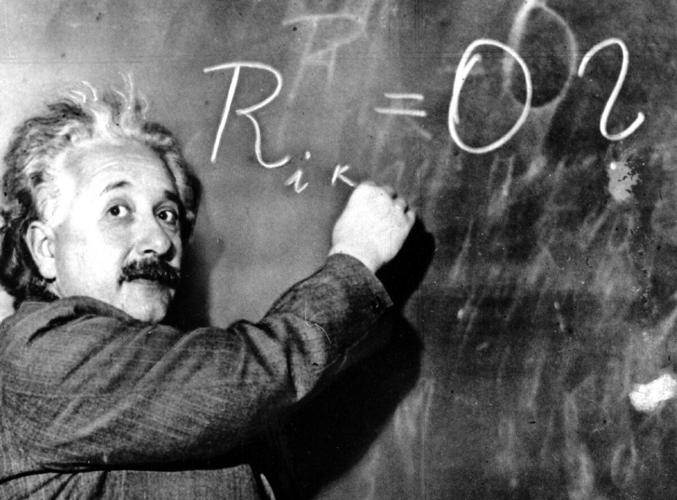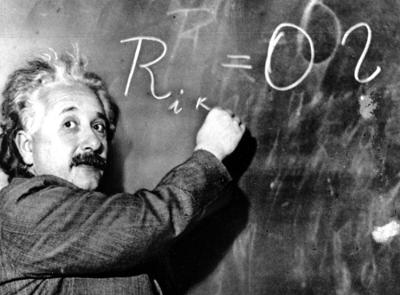It was a warm fall day when Alexander Sachs walked into the lush, green grounds of the White House, but his thoughts were far from mellow.
It was Oct. 11, 1939, and he was charged with an urgent mission, bearing a letter that he, and a gaggle of little-known foreign scientists, hoped would save the civilized world, abruptly plunged into war with Nazi Germany.
The ŌĆ£Einstein letter,ŌĆØ as itŌĆÖs now known, was signed by the revered discoverer of the , which revolutionized physics, cosmology and astronomy. And Albert EinsteinŌĆÖs signature on the two-page typed document would play a historic role in a drama that would stretch for nearly six years and end with the dropping of the deadliest weapon ever imagined in the mid-20th century: the atomic bomb.
Other stories at from the Fall of 1939 series:
For Sachs, a 46-year-old Russian-born Harvard graduate and former economic adviser to President Franklin Roosevelt, the audience with the overburdened leader was of crucial importance. Germany and the Soviet Union had invaded Poland, all of Europe was on a knifeŌĆÖs edge and the brief era of post-First World War stability was over.
The letter Sachs carried ŌĆö written and painstakingly revised over a period of weeks ŌĆö was largely the work of Hungarian ├®migr├® Leo Szilard, a 41-year-old physicist who had fled the Nazis in the early 1930s for England and discovered the theory of a nuclear chain reaction.
It called for ŌĆ£watchfulnessŌĆØ and ŌĆ£quick actionŌĆØ on the imminent development of a powerful new generation of bombs based on uranium and capable of destroying huge swaths of territory. America, it noted, had only small supplies of poor-quality uranium, while Germany had a grip on large stocks from seized Czechoslovakian mines ŌĆö a clear warning that Adolph Hitler planned to develop an atomic bomb.
The letter urged Washington to secure a supply of uranium ore. And it asked Roosevelt to appoint a co-ordinator to update the government about chain reaction work by scientists in America and help speed up experimental work in university labs.
It was, in fact, a carefully worded call to atomic arms, one that has echoed down decades of praise and protest, and pointed the way to unleashing a fearsome force that changed the worldŌĆÖs geopolitical order.
With the dawn of the Atomic Age, says Nobel laureate and University of ║ŻĮŪ╔ńŪ°╣┘═°chemist John Polanyi, ŌĆ£we were in on something as important as when fire was discovered. The era changed as surely as the Stone Age led to the Bronze Age.ŌĆØ
The vastness of the change exploded into public consciousness with the August 1945 bombing of Hiroshima, which vapourized humans into terrifying shadows in seconds. But the events that led to the atomic bomb were far less dramatic, meandering over two continents for more than a decade, unnoticed by most non-scientists.
ŌĆ£Before the war, scientists often said they thought of physics as almost a spiritual discipline because it seemed to have so little relationship to the practical world of machines and bombs,ŌĆØ says Richard Rhodes, author of the Pulitzer Prize-winning history The Making of the Atomic Bomb.
Szilard himself had little idea of how a nuclear chain reaction might be achieved when the theory came to him in London, before he emigrated to New York. Nor was he immediately aware of its potential power.
That dawned on him in 1934, after spending a sunny afternoon on the lawn of Michael PolanyiŌĆÖs home in Manchester. The eminent scientist and philosopher, father of John Polanyi, was a friend and confidante with whom Szilard could discuss his radical theories without being labelled a fantasist.
But after returning to London, Szilard fired off an embarrassed telegram: ŌĆ£he had sat in our garden calculating the temperature that would be reached by an atomic bomb,ŌĆØ said John Polanyi. But on reflection, Szilard had drastically underestimated its power.
ŌĆ£Temperature obviously about 1,000 to 10 thousand million centigrade,ŌĆØ he wrote in his neat, methodical script.
Szilard was not the only scientist working on the nuclear issue. Italian expat Enrico Fermi won a Nobel Prize for landmark discoveries of new radioactive elements, and producing nuclear reactions with slow neutrons. Scientists in Berlin were experimenting with subatomic particles. For Szilard, the question was who would be the first to produce an atomic bomb.
Enter Einstein.
In the summer of 1939, Szilard was preoccupied with uranium ŌĆö which he believed would be the crucial ingredient in a bomb. And he worried that Hitler would buy up large supplies from the Belgian-ruled Congo.
Einstein, who once collaborated with him on an invention in Berlin, was now world famous, the poster boy for a science that everyone revered and almost no one could understand.
Furthermore, he knew Queen Elisabeth of Belgium, and could warn her of the dangers of allowing German purchases of uranium.
On July 16, with fellow physicist Eugene Wigner ŌĆö who also worried about GermanyŌĆÖs atomic ambitions ŌĆö Szilard set out by car for the Long Island summer cottage where Einstein was vacationing. But the two brilliant scientists were soon lost, bumbling around the back roads with no exact destination.
ŌĆ£We were at the point of giving up,ŌĆØ Szilard confessed to Rhodes, ŌĆ£when I saw a boy aged maybe 7 or 8 standing on the curb. I leaned out of the window and (said) ŌĆśSay, do you by any chance know where Professor Einstein lives?ŌĆÖ The boy knew that and he offered to take us there.ŌĆØ
Einstein, shock-haired and dishevelled as his portraits, greeted them from his porch. But the great theoretician was nonplussed by their request: he had never considered a chain reaction.
When Szilard explained ŌĆö an explosive chain reaction could be produced in uranium layered with graphite, by neutrons released by nuclear fission ŌĆö Einstein responded, ŌĆ£I never thought of that!ŌĆØ
But, Szilard told Rhodes, ŌĆ£he was very quick to see the implications and was perfectly willing to do anything that needed to be done.ŌĆØ Instead of writing the queen, he suggested a member of the Belgian cabinet.
However, the three scientists realized they should not act on their own on such a crucial matter of national security: a cover letter should be obtained from the U.S. State Department. Einstein and Szilard drafted, and revised, a number of explanatory letters they hoped to dispatch to officials in Washington.
It was no small matter for a group of foreign-born scientists, even under the signature of Einstein. A go-between was needed.
Szilard contacted Sachs, a biologist and economist who had gained RooseveltŌĆÖs ear. After digesting the contents of the letter, Sachs convinced Szilard that instead of wading into the bureaucracy, he should reach for the top ŌĆö approaching the president himself.
It was a bold plan. But Roosevelt had much on his mind. By the time the scientistsŌĆÖ letter had been revised ŌĆö with added input from physicist Edward Teller ŌĆö the Nazis had , and on Sept. 3, Britain and France declared war. The Atlantic naval battle began, and France prepared for a German invasion. Canada, meanwhile, declared war on Germany, while the U.S. remained neutral until December 1941.
The mounting crisis raised the scientistsŌĆÖ anxiety level. Although a long-time pacifist, Einstein feared GermanyŌĆÖs growing belligerence. As days went by without progress from Sachs, he called for quicker action to bring the atomic threat to RooseveltŌĆÖs attention.
Sachs had hung back in the hope of gaining a lengthy meeting to plead their case with the president. But as the exasperated scientists gave him an ultimatum for delivering the letter, he at last departed for Washington.
On arrival at the White House on Oct. 11, things did not go smoothly. At first, RooseveltŌĆÖs aide, Gen. Edwin Watson, kept him waiting, while he and his staff reviewed SachsŌĆÖs agenda. ŌĆ£When he was convinced that the information was worth the presidentŌĆÖs time, Watson let Sachs inside the Oval Office,ŌĆØ wrote Rhodes.
Once inside, Sachs applied all his shrewd ingenuity to his task. After drinking a glass of the presidentŌĆÖs rare Napoleon brandy, he launched into an amateurŌĆÖs-eye view of the Einstein-Szilard letter, which he had rewritten for the occasion.
In about 800 words, he explained the power of nuclear energy for electrical supplies, medical uses ŌĆö and ŌĆ£bombs of hitherto unenvisaged potency and scope.ŌĆØ He urged making arrangements with Belgium to obtain uranium supplies, and suggested that private foundations and American industry might be willing to share the cost of development with the government. And he asked Roosevelt to appoint a liaison official and committee to communicate with the scientists and U.S. administration.
The summary neatly covered all the political, economic and scientific bases. But it may have been SachŌĆÖs improvised ending that won over the president.
In it he quoted from a lecture by the British scientist Francis Aston, who declared that nothing could prevent the power of ŌĆ£subatomic energyŌĆØ from being harnessed for better or worse, and that we ŌĆ£can only hope that (mankind) will not use it exclusively in blowing up his next-door neighbour.ŌĆØ
Roosevelt immediately grasped the point. ŌĆ£What you are after is to see that the Nazis donŌĆÖt blow us up,ŌĆØ he said. With that, he called for action.
The atomic project started auspiciously. Sachs met with Bureau of Standards director Lyman Briggs, and a first meeting of the Advisory Committee on Uranium was set up within 10 days.
But there WashingtonŌĆÖs drive for an atomic bomb hit a roadblock ŌĆö stalled until 1940, when the British government turned over vital nuclear secrets developed by ├®migr├® scientists. ŌĆ£Among them was a summary saying not only that a bomb was possible, but how youŌĆÖd go about building one,ŌĆØ said Rhodes.
Even so it would be more than a year before the National Academy of Sciences submitted a report that Roosevelt approved, and which led to the Manhattan Project, launched in 1942, and the first atomic bomb.
Why did Briggs pull back on AmericaŌĆÖs early development of a bomb? ŌĆ£He was extremely concerned about security and he put the letter in the safe and locked it up,ŌĆØ said Rhodes. ŌĆ£There was also a lot of pre-war inertia on the part of the U.S. scientific establishment. So not much got done out of the Sachs effort to get the letter to Roosevelt.ŌĆØ
Now, the expert consensus is that the Einstein letter, however iconic, played a small role in raising the mushroom cloud over Hiroshima.
ŌĆ£The Uranium Committee was only a precursor organization to the Manhattan Project,ŌĆØ said Alex Wellerstein of the Stevens Institute of Technology in New Jersey, in an email. ŌĆ£The real work on the bomb did not start until several years later when a totally different group of scientists took over that work and pushed it into a new phase of development.ŌĆØ
Szilard, Teller and Wigner did take part in the Manhattan Project ŌĆö although Szilard vigorously opposed the plan to drop an atomic bomb on Hiroshima, and led a petition against it. But Einstein, ironically, was barred from secret government research because his background as a pacifist who opposed the war in Germany made him ŌĆ£unreliable.ŌĆØ
Einstein had turned against war early in life. But like other scientists who became dedicated anti-nuclear activists after Hiroshima and Nagasaki, he felt revulsion for the burgeoning atomic arsenals that resulted from the Manhattan Project, and threatened the future of the world.
Even his small part in the development of the bomb filled him with regret.
Years later, at Princeton University, recounts John Polanyi, ŌĆ£Einstein said if heŌĆÖd known what his involvement would have led to he would have become a plumber instead.ŌĆØ






























